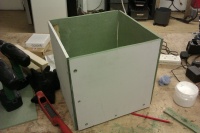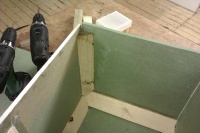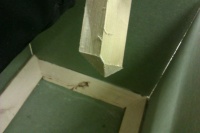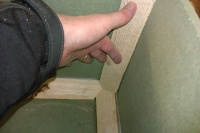Rubik's Cube Footrest: Difference between revisions
Jump to navigation
Jump to search
No edit summary |
No edit summary |
||
| Line 2: | Line 2: | ||
* scale and design | * scale and design | ||
** A Rubik's Cube is typically 58mm along one edge. Each edge is subdivided into 3. | |||
** the footrest wants to be a convenient height for use as a small coffee table as well as a good height for a typical couch. | |||
* scrap 9mm MDF sheet cut to 33cm square | * scrap 9mm MDF sheet cut to 33cm square | ||
[[File:Cube-footrest-IMAG1594.jpg|200px|thumb|right|A rough MDF box]] | |||
* scrap softwood timber for corner strengthening | * scrap softwood timber for corner strengthening | ||
[[File:Cube-footrest-IMAG1595.jpg|200px|thumb|right|45 degree scrap wood corners]] | |||
[[File:Cube-footrest-IMAG1596.jpg|200px|thumb|right|Cut to exact angles with mitre saw]] | |||
[[File:Cube-footrest-IMAG1597.jpg|200px|thumb|right|Glued and screwed in place]] | |||
* hinges | * hinges | ||
** hidden - want to lift without damaging the back overhanging edge | ** hidden - want to lift without damaging the back overhanging edge | ||
Revision as of 14:41, 13 February 2012
A small piece of custom furniture in the style of a Rubik's Cube.
- scale and design
- A Rubik's Cube is typically 58mm along one edge. Each edge is subdivided into 3.
- the footrest wants to be a convenient height for use as a small coffee table as well as a good height for a typical couch.
- scrap 9mm MDF sheet cut to 33cm square

- scrap softwood timber for corner strengthening



- hinges
- hidden - want to lift without damaging the back overhanging edge
- http://www.screwfix.com/p/easy-mount-hinges-90-pack-of-2/38662
- casters/gliders
- edges - nicely rounded
- quadrant or routing
- surface detail and finishing
- routing for 3x3x3 divisions
- filling and painting - black non-gloss matt vinyl
- GripFill - can it be sanded? http://www.screwfix.com/p/gripfill-350ml/10261
- stickers - use vinyl from old stationery - binders and dividers
- coasters for white stickers
- decor and detail on underside and inside?